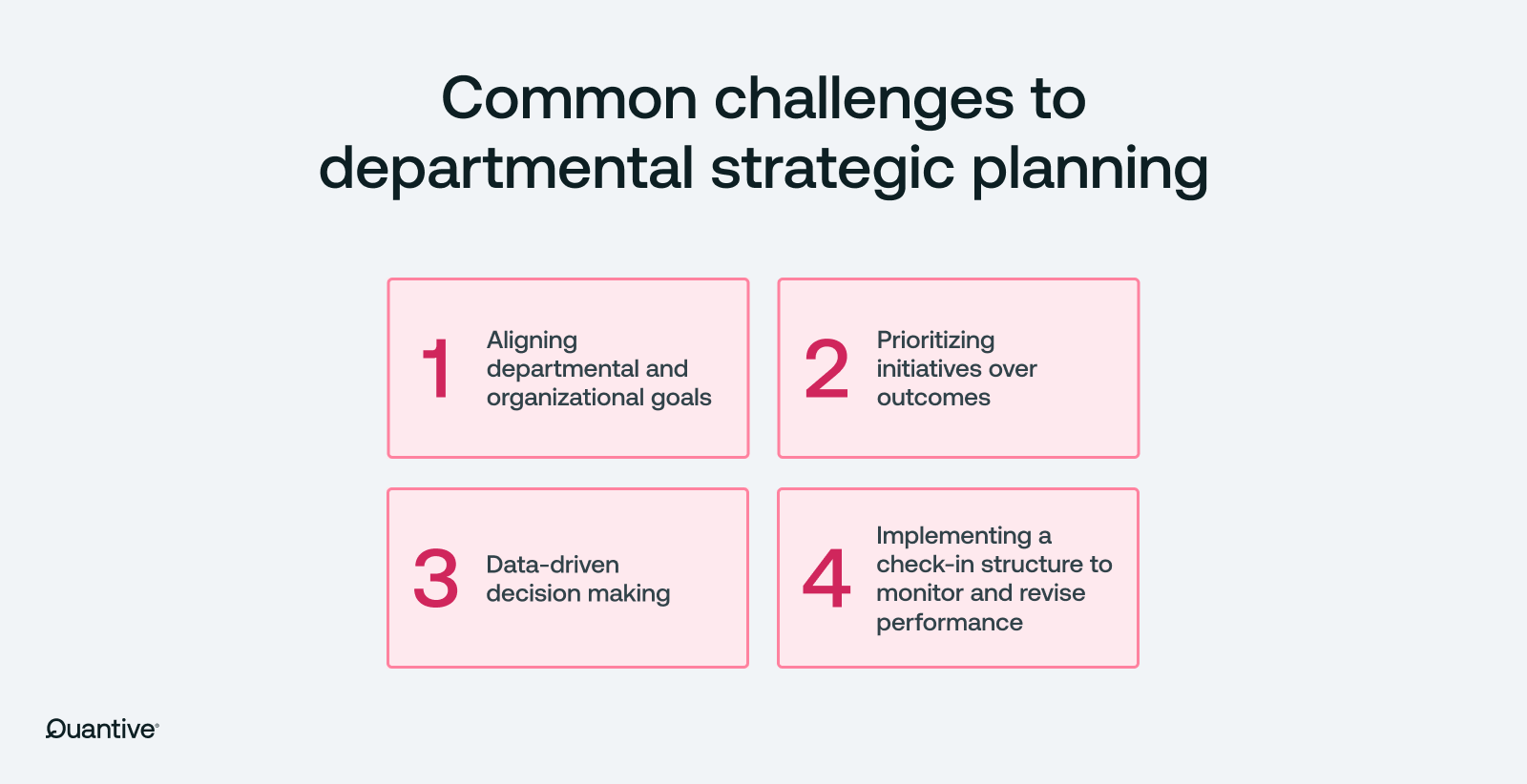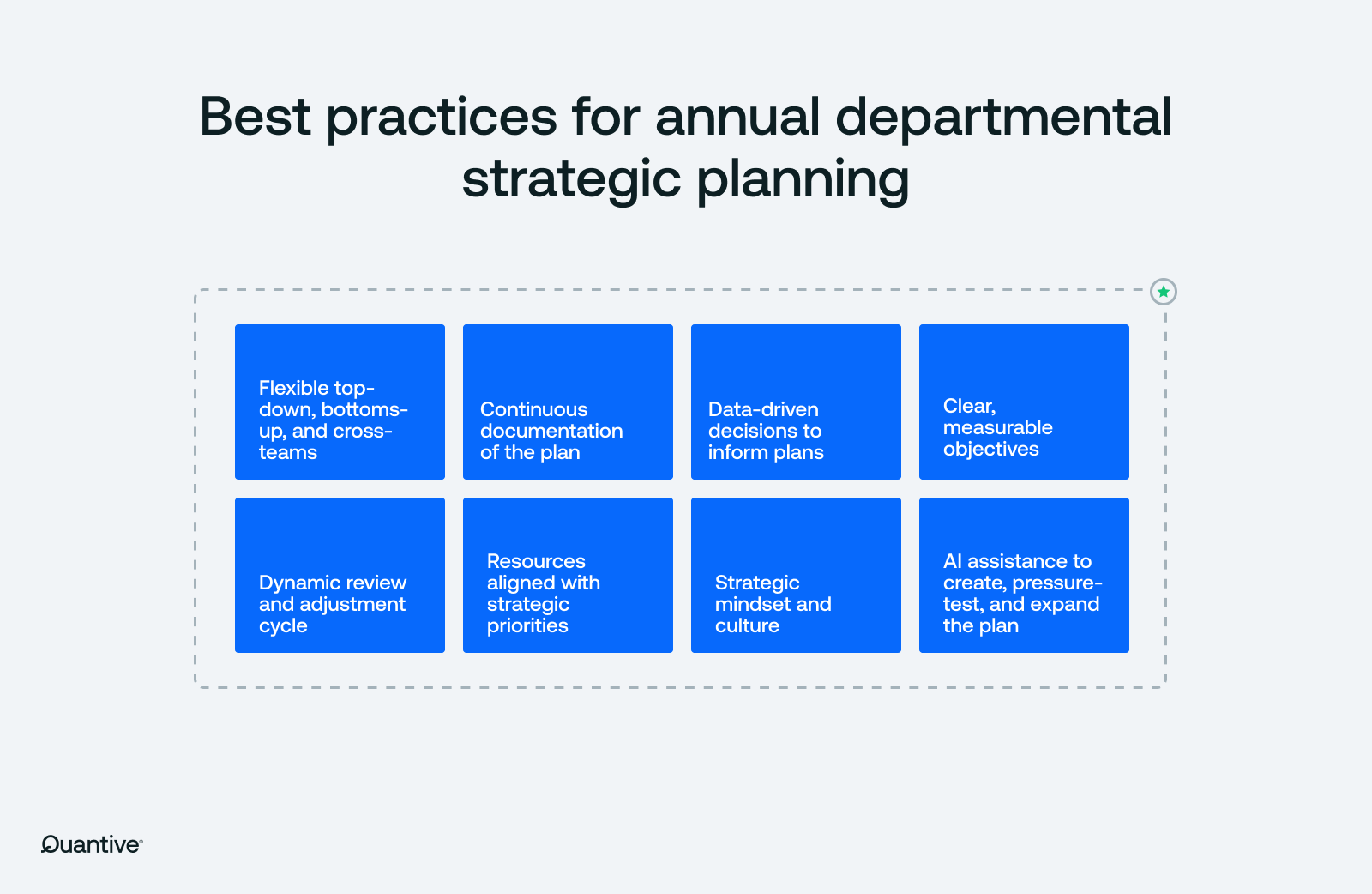Quantive is now part of WorkBoard. Get to know WorkBoard:
As the year draws to a close, leaders of large departments and business units within sizable organizations face a critical task: strategic planning for the upcoming year.
Aligning departmental goals with overarching business objectives, ensuring transparency, and fostering collaboration across functions can feel like a juggling act. Yet, when executed effectively, a well-crafted departmental plan does more than just guide operations — it becomes the engine driving achievement against company goals and growth.
Every organization eventually arrives at the end of the planning process. But there’s often a lingering sense that it could have been done better — a feeling fueled by individual contributors grappling with organizational and team goals they don’t fully understand or those questioning the reasoning behind certain initiatives.
This article will equip departmental leaders with actionable insights on navigating the annual strategic planning process. By embracing transparency, data-driven decision-making, and agility, you can build a robust plan that aligns with your organization’s overarching objectives and empowers your team to execute with confidence and purpose.
What is a departmental strategic plan?
Much like strategic planning at the organizational level, corporate annual planning leverages your company’s vision, mission statement, and core values to shape long-term objectives and direct your team's efforts. Strategic planning helps create a company's operational plan.
A departmental strategic plan bridges the gap between where your department is now and where it needs to be to support your organization’s top-line goals. It provides a clear, actionable framework that answers three essential questions:
- Where are you now? An assessment of the current state of your department, including performance metrics and resource allocation.
- Where do you want to be? The desired future state aligned with the company’s overall objectives.
- How will you get there? The strategies, initiatives, and tactics that will propel your department toward its goals.
Understanding the broader organizational context
At Quantive, we believe organizational alignment is the foundation of any successful strategy. The goals set at the top should serve as a guiding star for every department. Without this alignment, departmental plans risk becoming a collection of disconnected initiatives rather than a cohesive strategy that propels the company forward.
Start by conversing with senior leadership to gain a deep understanding of each department’s strategic priorities. Alignment is more than just a checkbox — it's about ensuring that every action your department takes contributes to the organization’s overall success.
To ensure that each department is aligned with the broader organizational strategy, you must analyze how the previous year has gone. Make sure each team is equipped to meet its goals by asking the following questions:
- Alignment with organizational objectives: Are our current initiatives directly supporting the company’s top-level goals? Where do we see potential misalignment between our department’s efforts and the broader business strategy? What can we learn from the alignment hiccups from the past year?
- Progress toward existing departmental goals: How are we tracking against the key metrics we set at the beginning of the year? Which goals are on track, and which need more focus? Are there any roadblocks hindering our progress?
- Leverage data effectively: What data and analytics should we be utilizing to guide our decision-making? What insights have we gained from data that can inform our future initiatives? How can we improve our data usage to drive better outcomes?
- Past learnings: What initiatives have been particularly successful, and why? Where did we fall short, and what were the contributing factors? How do last year’s top-level objectives for the organization compare to this year’s?
- Collaboration with other departments: Where are other business units in their planning? Are we actively engaging with other departments to ensure alignment and synergy? What opportunities exist for cross-functional collaboration that we haven’t yet explored?
- Adapting to changing circumstances: Do we have the flexibility to pivot our strategy if needed? What could significantly disrupt our strategy? What are the fundamental assumptions, and how unmoveable are they?
Balancing top-down and bottom-up planning
Effective departmental planning requires a delicate balance between top-down directives and bottom-up insights. While each department must support the company’s overarching goals, leveraging your unit's unique strengths and opportunities is equally important.
Transparency is crucial here. Leaders must provide their teams with a clear view of the company’s ambitions, and desired state, including expected KPIs and potential obstacles. When everyone understands the broader organizational context, creating a plan that aligns with and actively supports the company’s goals becomes easier.
A departmental strategic plan should empower your team to make decisions that are informed, focused, and aligned with the bigger picture.
Defining departmental goals and objectives
Too often, strategic plans become lists of initiatives — things to do rather than outcomes to achieve. This can lead to a scattershot approach where activities are prioritized based on ease or familiarity rather than impact.
Instead, start with the desired outcomes and let those dictate the initiatives. What business results do you need to achieve? From there, determine the actions that will get you there.
Many leaders face the pressure to deliver quick results, often at the expense of strategic thinking. We always advocate for a focus on outcomes rather than initiatives.
Instead of getting bogged down in how something should be done, concentrate on what needs to be accomplished. A data-driven approach is invaluable in this stage — historical performance data, market trends, and customer insights should inform your goals. This ensures that your objectives are grounded in reality and helps you anticipate potential challenges and opportunities.
Incorporating cross-functional collaboration to break down silos
Departments shouldn’t operate in a vacuum. For a strategic plan to be truly effective, it must consider how your goals intersect with other business areas. By engaging other departments in the planning process, you ensure that your goals are aligned with the company’s strategy and complementary to the efforts of other teams.
Examples of department goals
Sales department goal: Increase annual revenue by 20%
- Target result: Achieve a 15% increase in average deal size by targeting higher-value clients
- Target result: Expand into three new geographic markets to diversify the customer base
- Target result: Improve lead conversion rate by 10% through enhanced sales training and updated CRM tools
Marketing department goal: Boost brand awareness by 30% in key markets
- Target result: Launch a targeted digital advertising campaign across social media and search engines, aiming for a 50% increase in website traffic from these channels
- Target result: Develop and distribute 12 high-quality content pieces (e.g., whitepapers, case studies) to position the company as a thought leader in the industry
- Target result: Increase email newsletter subscribers by 25% through optimized lead-generation strategies
Customer support department goal: Enhance customer satisfaction and reduce churn by 10%
- Target result: Achieve an 85% first-contact resolution rate by empowering support teams with better tools and resources
- Target result: Reduce average response time to customer inquiries by 30% by optimizing workflow and staffing
- Target result: Implement a customer feedback system that gathers actionable insights, aiming for a 15% increase in customer satisfaction (CSAT) scores
By focusing on specific, measurable outcomes, departments can align their efforts with the company's broader objectives, ensuring that every action propels the organization closer to its goals.
Building a robust departmental plan
Outlining the initiatives, timelines, and resources needed to achieve your objectives is not a one-size-fits-all process. Each department is unique, and your plan should reflect your team's specific challenges and opportunities. (Check out our 2025 OKR guide for more information on setting company OKRs).
Start by breaking down your goals into actionable steps. What initiatives will drive the outcomes you’ve identified? Who will be responsible for each initiative? What resources are required? This is where transparency and collaboration become critical. Involving your team in the planning process fosters buy-in and ensures everyone is on the same page.
No strategy is perfect from the outset. It’s essential to pressure-test your plan against various scenarios — market changes, competitive shifts, and macroeconomic trends. This process can be complex and time-consuming, but it becomes more manageable with solutions like
Quantive StrategyAI, our AI-powered platform, can simulate different scenarios, identify potential risks, and highlight weaknesses in your strategy, allowing you to adapt before it’s too late.
4 common challenges to departmental strategic planning and how to solve them
Several common challenges can derail even the best-laid annual business planning, but these obstacles can be overcome with the right approach:
- Aligning departmental and organizational goals
- Prioritizing initiatives over outcomes
- Data-driven decision making
- Implementing a check-in structure to monitor and revise performance
Aligning departmental and organizational goals
Misalignment derails progress and leads to wasted resources, missed opportunities, and frustration across teams. Begin with well-defined goals that tie directly to the organization’s mission and long-term goals. This vision should be communicated to every team member, ensuring everyone understands how their role contributes to the bigger picture.
Transparency is the backbone of alignment. Regularly share updates on the company’s strategic direction, key performance indicators (KPIs), and the rationale behind critical decisions. Outline expectations around collaboration, roles, and goal ownership. Open communication channels allow for feedback and ensure everyone is on the same page.
Remember that organizational alignment is a gradual process. Give your team the time to build confidence in their decision-making and to fully embrace ownership of their goals. Throughout this transition, prioritize supporting and empowering your employees to ensure their success.
Prioritizing initiatives over outcomes
It’s easy to get caught up in the specifics of what needs to be done during the annual planning process, and this can lead to a lack of focus. Instead, keep your eye on the prize — what are the key outcomes that will drive success for your department and the organization? By focusing on these outcomes, you can ensure your initiatives align with your strategic objectives.
To avoid this, develop a clear, practical strategic plan for bridging the gap between now and the future. This includes short- and long-term approaches to your departmental goals.
From this strategic annual plan, you can create a detailed action plan, covering things like:
- Timelines: When will we take each step, and what are the deadlines?
- Milestones: What key achievements will ensure consistent progress?
- Resource requirements: What’s needed to achieve each step?
- Responsibilities: Who's accountable in each step?
- Risks and challenges: What can affect our ability to execute our plan? How will we address these?
Data-driven decision making
While data can provide invaluable insights, it’s often underutilized or misinterpreted. To address this, make data accessibility a priority and ensure your team has the tools and training to leverage data effectively.
Invest in technologies that offer real-time tracking and reporting of key performance indicators, with dashboards and monitoring systems that provide up-to-date insights. These allow you to gather, process, and interpret real-time data for proactive decision-making that aligns with the current business landscape.
Quantive StrategyAI streamlines this process, providing real-time analytics and insights that empower your team to make informed decisions.
Implementing a check-in structure to monitor and revise performance
The absence of a feedback loop between strategy formulation, execution, and evaluation can hinder a company’s ability to adapt and improve, limiting the potential to refine strategies based on real-time performance data.
Implementing an Always-On strategy through a structured feedback loop ensures that strategic adjustments are continuously informed by execution and evaluation. Regular check-ins enable departments to stay agile, quickly responding to performance or market conditions changes.
Companies can maintain company-wide visibility by encouraging employees to share insights and fostering a culture of continuous improvement. This operational transparency sustains high performance, collaboration, and strong employee relationships and builds a trust-driven environment where clear insight into goal progress enhances the quality of feedback and knowledge-sharing.

Best practices for annual departmental strategic planning
Successfully navigating the complexities of the annual business planning process requires more than just overcoming challenges. It demands adherence to a set of guiding best practices that ensure your plan is well-crafted and effectively implemented. Here’s how to approach the process:

1. Embrace flexibility
A rigid, one-time approach to strategic departmental planning won't suffice. Your plan must be flexible and adaptable to remain relevant amidst evolving circumstances. This flexibility ensures your department can pivot when necessary, aligning with broader organizational goals.
2. Prioritize continuous documentation
Ongoing documentation throughout the strategic planning process is vital. It captures the key elements of your strategy, making it easier to communicate and update as needed. Everyone on the same page ensures that the strategic plan remains current, clear, and actionable.
3. Make data-driven decisions
Basing your strategic decisions on data rather than assumptions is crucial for accuracy and effectiveness. Leveraging data ensures that your objectives are grounded in reality, allowing for better prioritization and reducing the risk of biased or flawed decision-making.
4. Set clear, measurable objectives
Ensure your department's goals are specific, measurable, achievable, relevant, and time-bound (SMART). Clear objectives provide a roadmap for your team and make tracking progress, assessing performance, and making necessary adjustments easier.
5. Establish a review and adjustment cycle
Set up a regular cycle for reviewing and adjusting your departmental strategic plan. This could be quarterly or bi-annually, depending on your needs. Frequent reviews ensure that the plan remains relevant and allows your department to respond effectively to changes in the business environment.
6. Align resources with strategic priorities
Ensure that your department’s resources — time, budget, personnel — are aligned with your strategic priorities. Proper resource allocation is crucial for executing the plan and achieving departmental goals.
7. Align departmental culture with the departmental strategic plan
The success of your strategic plan heavily depends on the alignment between your department’s culture and its objectives. A supportive culture — where behaviors, rules, and attitudes are in sync with strategic goals — optimizes the execution of your plan. Ensuring your team is on board with the plan fosters commitment and drives performance.
8. Leverage AI
Incorporating AI into your departmental strategic planning can significantly enhance your ability to adapt and respond to changes. AI supports the development of an Always-On strategy, allowing for real-time environmental scans, streamlined planning phases, and data-driven insights. This increases transparency and accountability and drives engagement and alignment with the strategic objectives, ensuring your department remains agile and competitive.
Key takeaways
A well-crafted departmental plan is more than just a roadmap — it’s the engine that drives your department’s success. By focusing on outcomes, leveraging data, embracing technology, and maintaining flexibility, you can create a plan that aligns with the company’s goals and positions your department as a key player in achieving them.
As you approach this year’s planning process, consider how solutions like Quantive StrategyAI can help you overcome common challenges and build a strategy that is effective and resilient in the face of change.
Quantive empowers today’s organizations to transform their departmental ambitions into actionable outcomes through strategic agility. By integrating strategy, teams, and data, Quantive enables effective decision-making, streamlined execution, and enhanced performance.
An Always-On Strategy is crucial for continuously aligning current efforts with desired outcomes. Quantive provides the tools, expertise, and innovation needed to evolve your departmental plans from static blueprints into dynamic, feedback-driven growth engines.
Whether you’re a fast-growing startup, a mid-market company aiming to scale, or a large enterprise pursuing innovation, Quantive ensures you stay ahead at every turn. Learn more at www.quantive.com.





